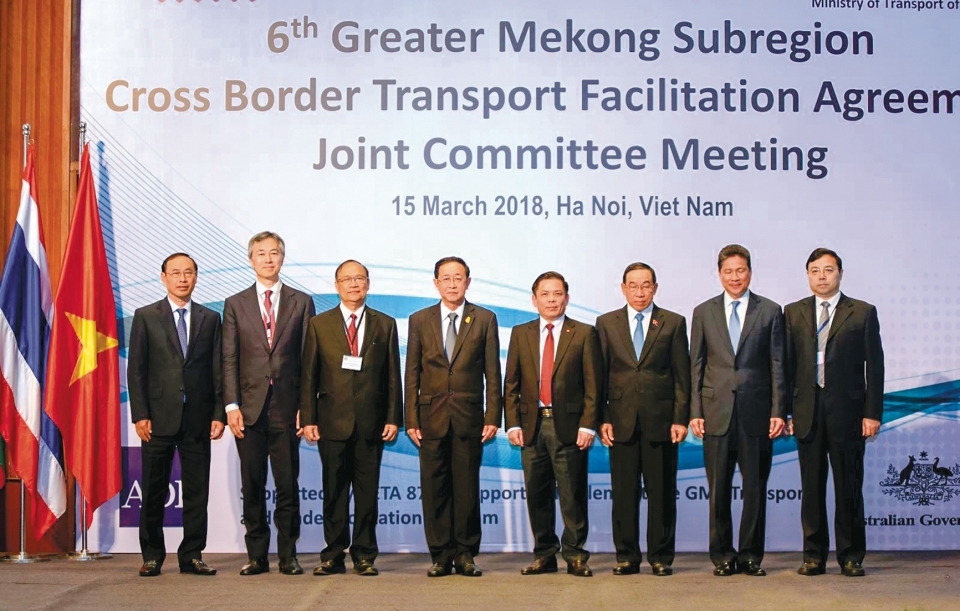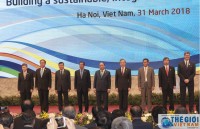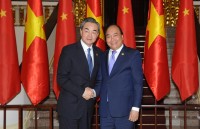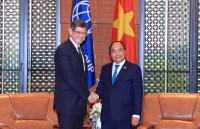
Developing infrastructure to promote transportation connectivity in GMS countries
Latest
| TIN LIÊN QUAN | |
| GMS leaders approved Joint Statement | |
| Sixth Greater Mekong Subregion Summit a success | |
Mr. Deputy Minister, can you share with us the achievements of connecting transportation among 6 countries under the cooperative framework of GMS so far?
Vietnam has actively participated in a number of frameworks including the GMS one. This is a cooperation framework sponsored by the Asian Development Bank (ADB) and comprised of 6 participating countries: Vietnam, China, Laos, Cambodia, Thailand, and Myanmar. Transportation connectivity is the top priority in the GMS. The transportation strategy in the coming time recommends expanding the scope of the hardware infrastructure which connecting GMS in roads and railways.
 |
| Representatives from GMS countries at the Cross Border Transport Facilitation Agreement Joint Committee Meeting in Ha Noi. |
Regarding infrastructure, based on road infrastructure connectivity which has basically been completed in GMS countries (except Myanmar which has just been removed from the embargo), the strategic framework recommends GMS countries to focus on developing multi-modal transportation, integrating railways transport, improving road safety, and ensuring climate change assessments’ integration into transportation projects.
Regarding railways, the countries agreed to prioritize re-determining cross-national railways, differences in technical, operational, and infrastructure standards, identifying border railway stations, and establishing the GMS Railway Association.
In particular, the GMS member countries pledged to effectively implement the GMS-CBTA; focus on the application of policies to facilitate the flow of people and goods across borders, thereby promoting cooperation and economic development; transform the infrastructure coordinately built by the countries into economic corridors which encourage exchanges of goods, people and assets; create jobs, develop tourism and trade, and form a bond of interests and peace in the region.
To achieve the above-mentioned goals all together, how has Vietnam participated in this program?
Under this framework, Vietnam, with the support of sponsors including ADB and the country’s internal forces, has been completing a series of important foreign corridor connections. With China, we have fully utilized the Kunming – Lao Cai – Ha Noi – Hai Phong highway since 2015.
According to the plan, Vietnam will complete and put into operation the Nanning – Lang Son – Ha Noi – Hai Phong highway, followed by the Hai Phong – Ha Long – Van Don – Mong Cai – Pingxiang highway before 2020. The Hai Phong – Ha Long leg will be completed in the 2nd quarter of 2018, while the Ha Long – Van Don – Mong Cai leg is ready to receive the investment from Quang Ninh People’s Committee.
On the corridor connecting Vietnam - Laos, there is a 1,450km long route line of from Da Nang - Dong Ha port along No. 1 National Highway - Lao Bao and No. 9 National Highway of Vietnam – No. 9 National Highway of Laos to Thailand – Dawei port of Myanmar (the Myanmar leg is under construction). This is an important corridor that cuts short the distance from the Pacific to the Indian Ocean and vice versa (3 days by road). In case the goods transported by sea through the Malacca Strait, it undergoes 6,000 km in 10 days.
The 2nd East – West Corridor running through No. 217 Highway is under preparation by ADB. On the basis of the East – West route being exploited to link the Pacific and Indian Oceans, Vietnam and Laos have studied and launched the initiative of the corridor from Myanmar to Thailand and Laos (via the Friendship Bridge No. 5 between Laos and Thailand) and runs along the Pac San – Thanh Thuy – Vinh to Vung Ang port. This is a branch of the strategic Ha Noi – Vientiane highway which the governments of Vietnam and Laos are determined to finish construction.
To connect with Cambodia, the Southern corridor and the Southern Coastal corridor were constructed with support from ADB. Regarding the 180km long Ho Chi Minh City – Phnom Penh highway, Vietnam and Cambodia have signed an agreement to promote construction investment. This highway will further benefit the connection with Cai Mep – Thi Vai port (from Ho Chi Minh City) and Thailand and Southern corridor (from Phnom Penh).
As a result, the transportation infrastructure linking GMS countries is relatively ensured. At the 6th meeting of the Implementation of the GMS-CBTA, ministers recognized the recent development of transportation infrastructure to promote regional connectivity corridors in the key sub-region; at the same time exchanged ways to turn built corridors into economic ones bringing about the development of trade, tourism… to member countries.
Specifically, which important issues have been discussed among the 6 member countries at this meeting?
The representatives of the six countries have focused on several key issues such as the completed corridors in order to organize cross–border transport should be added to Protocol No. 1. Vietnam has two lines including National Highway No. 12 that crosses Chalo Border Gate and National Highway No. 8 proposed to be added this time to effectively exploit Vung Ang Port as well as the East – West Economic Corridor (Vung Ang – Road 12 through Laos and to Thailand). They also agreed to connect new cross-border corridors.
The ministers discussed an “Early Harvest” memorandum of understanding with specific timelines, measures for members to quickly organize the exploitation and implementation of the one-stop-shop model as well as transport and trade facilitation methods. The meeting ended successfully with the signing ceremony of the “Early Harvest” memorandum of understanding on the GMS-CBTA among the GMS member countries and the Joint Declaration of the 6th Joint Committee Meeting.
With this memorandum of understanding, how will cross-border transport be improved?
This memorandum of understanding will be a decree for countries to fulfill their commitments at the same time within the GMS framework. 6 countries will unify an effective implementation process of the one-stop-shop model, a process of guaranteeing vehicles that travel across border, and a common license for vehicles to enter all signatory countries via the corridors.
The countries will issue 500 licenses under Protocol 3 of the CBTA, and mutually recognize and accept these licenses. They will also implement the agreement’s regime for temporary imports of motor vehicles according to Article 18 of the Agreement and allow temporary imports to be exempted from various types of import tariffs and customs guarantees.
The memorandum of understanding plays an important role because it will create a legal framework allowing many types of vehicles participate in the cross – border transportation of people and goods, consequently various goods will be transported by road and rail instead of by sea, thus reducing logistics costs.
 | Building GMS, CLV regions of sustainable, prosperous development After three effective working days in Ha Noi from March 29-31, the sixth Greater Mekong Subregion Summit (GMS-6) and the 10th Cambodia-Laos-Vietnam Summit on Development ... |
 | Vietnam treasures comprehensive cooperation with China: PM Vietnam always treasures the friendship and comprehensive cooperation with China, regarding maintaining the stable and healthy relations with China as fitting the two countries’ fundamental ... |
 | PM urges WB to foster cooperation within GMS, CLV Prime Minister Nguyen Xuan Phuc hopes the World Bank will play a better part in promoting cooperation in the Greater Mekong Subregion (GMS) and Cambodia-Laos-Vietnam ... |

















